Yellampalli S. (ed.) Carbon Nanotubes - Synthesis, Characterization, Applications
Подождите немного. Документ загружается.

19
Nonlinear Optical Properties of Graphene and
Carbon Nanotube Composites
Jun Wang
1a
, Yu Chen
1b
, Rihong Li
1a
, Hongxing Dong
1a
, Long Zhang
1a
,
Mustafa Lotya
2
, Jonathan N. Coleman
2
and Werner J. Blau
2
1a
Key Laboratory of Materials for High-Power Laser, Shanghai Institute of Optics and
Fine Mechanics, Chinese Academy of Sciences
1b
Key Laboratory for Advanced Materials, Department of Chemistry,
East China University of Science and Technology
2
School of Physics and the Centre for Research on Adaptive Nanostructures and
Nanodevices (CRANN), Trinity College Dublin
1
China
2
Ireland
1. Introduction
The rapid development of nanoscience and nanotechnology provides lots of new
opportunities for nonlinear optics. A growing number of nanomaterials have been shown to
possess remarkable nonlinear optical (NLO) properties, which promotes the design and
fabrication of nano and nano-scale optoelectronic and photonic devices (Xia et al. 2003;
Avouris et al. 2008; Hasan et al. 2009; Bonaccorso et al. 2010; Loh et al. 2010; Coleman et al.
2011). The wonderful carbon allotropes discovered in recent decades are the most
representative products of nanotechnology: from 3D carbon nanoparticles (graphite), to 0D
fullerenes, to 1D carbon nanotubes (CNTs), and then to 2D graphenes discovered most
recently. Interestingly, all of these nano-carbons exhibit diverse NLO properties. For
instance, carbon black suspensions show strong thermally-induced nonlinear scattering
(NLS) effect and hence optical limiting (OL) for intense ns laser pulses (Mansour et al. 1992);
fullerenes show large third-order optical nonlinearity and reverse saturable absorption
(RSA) at certain wavelength band (Tutt et al. 1992); CNTs show ultrafast second- and third-
order nonlinearities and saturable absorption (SA) in the near infrared (NIR) region (Hasan
et al. 2009); and graphenes show ultrafast carrier relaxation time and ultra-broad-band
resonate NLO response (Bonaccorso et al. 2010).
Optical limiting is an important NLO phenomenon, which can be utilized to protect delicate
optical instruments, especially the human eye, from intense laser beams (Tutt et al. 1993). As
shown in Fig. 1, ideally an optical limiter should strongly attenuate intense, potentially
dangerous laser beams, while exhibiting high transmittance for low intensity ambient light.
Generally speaking, there are two main mechanisms for passive OL: nonlinear absorption
(NLA) and NLS. The former can be further divided into multi-photon absorption (MPA),
RSA and free-carrier absorption (FCA). Up to date, numerous inorganic and organic
materials, such as phthalocyanines (O'Flaherty et al. 2003; de la Torre et al. 2004), porphyrins
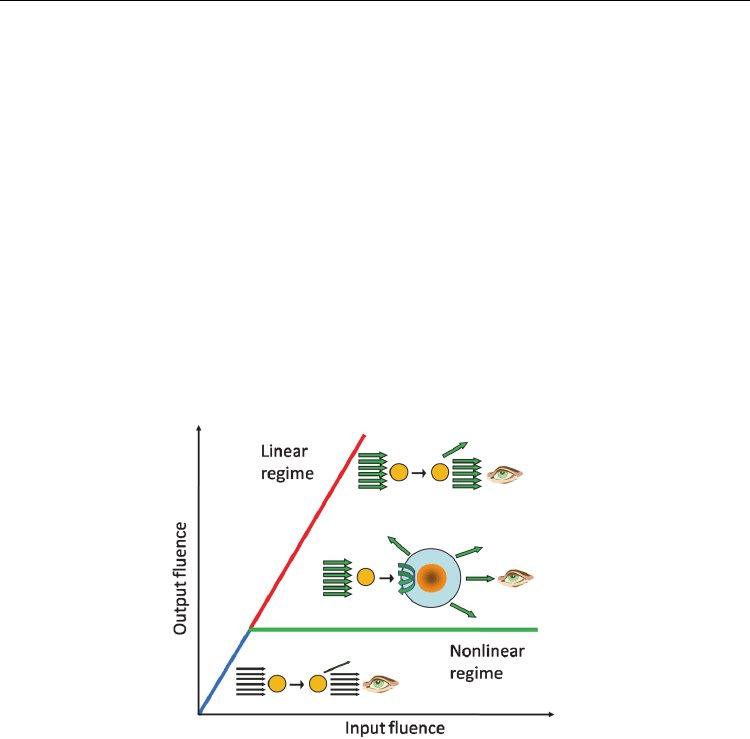
Carbon Nanotubes - Synthesis, Characterization, Applications
398
(Blau et al. 1985; Senge et al. 2007), organic dyes (He et al. 1995; He et al. 2008), metal
nanoclusters (Sun et al. 1999; Wang et al. 2009), quantum dots (He et al. 2007), etc. have been
found to possess OL response. Carbon-related nanomaterials are actually a main branch in
the field of OL materials (Chen et al. 2007; Wang et al. 2009). It has been confirmed that
fullerene shows RSA induced OL, and nanotubes and graphene show NLS induced limiting.
However, the most important point is that the advantage of these carbon nanomaterials
manifests themselves in tailorable chemical properties by binding functional materials, e.g.,
polymers, organic molecules and metal nanoparticles, forming versatile OL composites
(Chen et al. 2007; Wang et al. 2009; Bottari et al. 2010).
The large surface energy of nanotubes imposes restrictions on the formation of individual
nanotubes in most inorganic and organic solvents. For solubilized nanotubes, one can
employ polymers or organic molecules to functionalize, covalently or noncovalently, the
surface of nanotubes. In the same manner, pristine single- or few-layer graphene is also
difficult to exist stably in many organic solvents. It is thus very significant to design and
synthesize nanotube- and graphene-based solution-processed organic/polymeric materials,
which is a key step for the development of viable nano-carbon OL devices (Chen et al. 2007;
Wang et al. 2009).
Fig. 1. The response of an ideal optical limiter.
2. Mechanisms
2.1 Nonlinear scattering (NLS)
Thermally induced NLS may be the most common nonlinear phenomenon for various
nanomaterial systems, such as nanotubes, nanorods, nanowires, nanosheets, nanoribbons,
nanospheres, nanodots etc. (Wang et al. 2009). An effective scattering process can disperse
the highly intense beam into a larger spatial dimension and hence reduce the intensity of the
direct incident beam. According to Mie scattering theory, the nanoscale particles alone
cannot scatter a light beam effectively. The effective scattering arises from the formation of
scattering centres with size of the order of the wavelength of the incident laser beam. The
formation of scattering centres, initiating from nanoparticles, has three possible origins.
The induced scattering centres consist of two origins: the formation and growth of solvent
bubbles, which is due to the thermal energy transfer from the nanotubes to the solvent; and
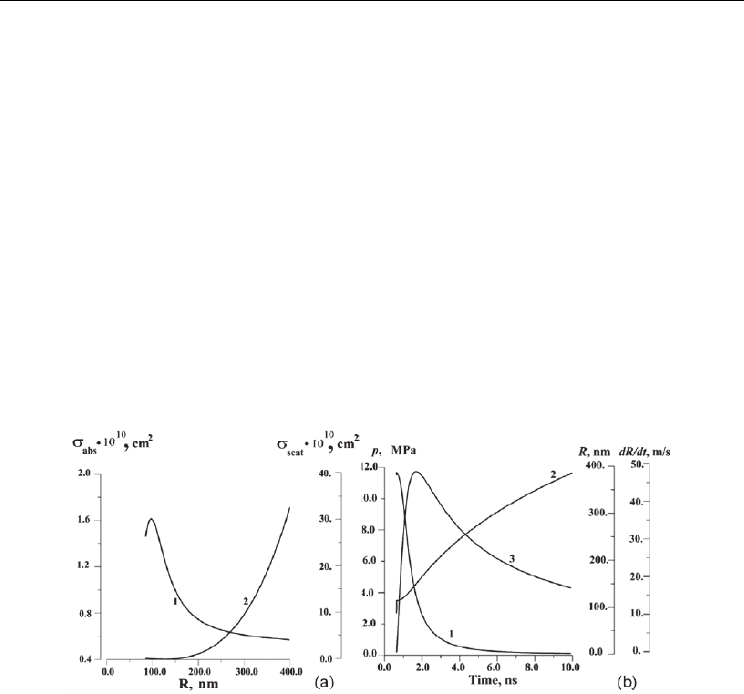
Nonlinear Optical Properties of Graphene and Carbon Nanotube Composites
399
the formation and expansion of carbon microplasmas, which is due to the ionization of
nanotubes. The former takes place at the lower incident energy fluence, while the latter
takes place at higher fluences. Belousova et al. developed a theoretical model to explain the
OL of carbon nanoparticles (Belousova et al. 2003; Belousova et al. 2004). In this model, the
whole limiting process is described theoretically by three steps: the dynamics of the
formation and expansion of solvent vapour bubbles; the Mie scattering of the expanding
bubbles; and the nonlinear propagation through the scattering medium. Although the
objects of modeling are quasi-spherical carbon nanoparticles, the Mie theory-based
prediction works qualitatively for nanotubes and is helpful for understanding bubble
growth dynamics and thus the OL process in CNT suspensions. As an example, Fig. 2a
shows the variations of absorption and scattering cross sections as radius of gas bubbles in
carbon nanoparticle suspensions, and Fig. 2b illustrates the inside pressure, expansion rate
and radius of a gas bubble as functions of illumination time (Belousova et al. 2004).
Moreover, Belousova’s simulation indicates that the scattering cross section increases
significantly with the increasing size of vapor bubbles, meanwhile the absorption cross
section decreases until it is negligible when the bubbles grow, effectively limiting the
incident power.
Fig. 2. Variations of (1) absorption and (2) scattering cross sections as radius of gas bubbles
in carbon nanoparticle suspensions (a), and the inside pressure (1), expansion rate (2) and
radius (3) of a gas bubble as functions of illumination time (b) (Belousova et al. 2004).
2.2 Reverse saturable absorption (RSA)
The process of RSA involves multi-step, excited state absorption (ESA) from the singlet
ground state to the first excited triplet state via the first excited singlet state. The most
representative materials include phthalocyanines, porphyrins, fullerenes, etc. A general five-
level model, as shown in Fig. 3, has been considered to simulate the RSA process in the
phthalocyanine system (O'Flaherty et al. 2003; O'Flaherty et al. 2004). The vibrational levels
of the electronic states are ignored. Generally, for this five-level system after initial
excitation, the first excited singlet state S
1
is populated, from here the electrons may be
subsequently excited into S
2
within the pulse width of the laser. Once in S
2
, they rapidly
relax to S
1
again. From S
1
, the population may undergo an intersystem crossing to the first
excited triplet T
1
with a time constant τ
isc
and thereafter undergo excitations and relaxations
to and from T
2
. Thus, the population is exchanged cyclically between S
1
and T
1
, as the
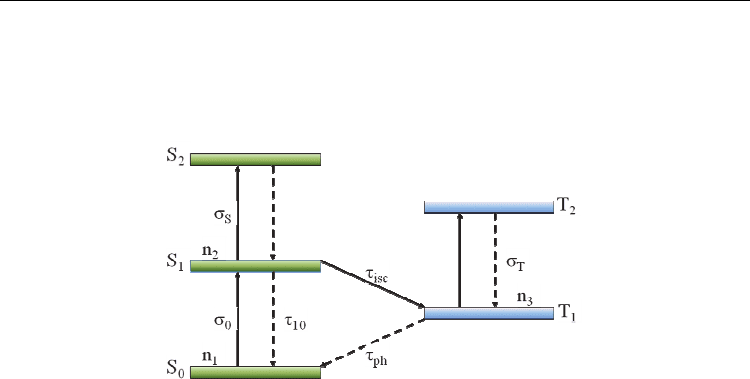
Carbon Nanotubes - Synthesis, Characterization, Applications
400
lifetime of T
1
(τ
ph
) is very long in comparison to τ
isc
. With further simplify matters, it was
assumed that relaxation out of states S
2
and T
2
is very rapid so that the population of these
two levels may be neglected. Furthermore, stimulated emission from S
1
is excluded due to
the small fluorescence quantum yield.
Fig. 3. Illustration of a five-level RSA process. Si represents singlet levels, and Ti represents
triplet levels. Solid arrows imply an excitation resulting from photon absorption and dashed
arrows represent relaxations.
The extinction of incident beam is governed by the propagation equation
∂I/∂z=-α
NL
I=-(σ
0
N
1
+σ
s
N
2
+σ
T
N
3
)I (1)
where the nonlinear absorption coefficient α
NL
is composed of the ground state absorption
σ
0
N
1
, the first excited singlet state absorption σ
s
N
2
and the first excited triplet state
absorption σ
T
N
3
. N and σ refer to the population and absorption cross section of specific
energy levels. Under the steady state approximation α
NL
can be derived in the form,
α
NL
(F,F
sat
,κ)=α
L
(1+F/F
sat
)
-1
(1+κF/F
sat
) (2)
where α
L
is the linear absorption coefficient, κ is the ratio of excited state cross section (σ
ex
)
to ground state cross section (σ
0
), κ=σ
ex
/σ
0
≈σ
T
/σ
0
, F represents the energy density and F
sat
is
the energy density at which the ground state absorption saturates (O'Flaherty et al. 2003;
O'Flaherty et al. 2004). This model reproduces the RSA effects and highlights the crucial role
that the ESA plays in the overall absorption coefficient. Considering this expression for the
nonlinear absorption coefficient, one can state that higher κ values combined with lower F
sat
values define more efficient OL ability.
2.3 Multi-photon absorption (MPA)
A multi-photon process is one which occurs through the simultaneous absorption of two or
more photons via virtual states in a medium, as shown in Fig. 4. Many metals,
semiconductor nanomaterials, quantum dots, organic chromophores and conjugated
polymers possess multi-photon absorption induced OL effects (He et al. 2008). For two-
photon absorption (TPA), the process can be described by a propagation equation with
“Beer-Lambert” format
∂I/∂z=-(α+βI)I (3)
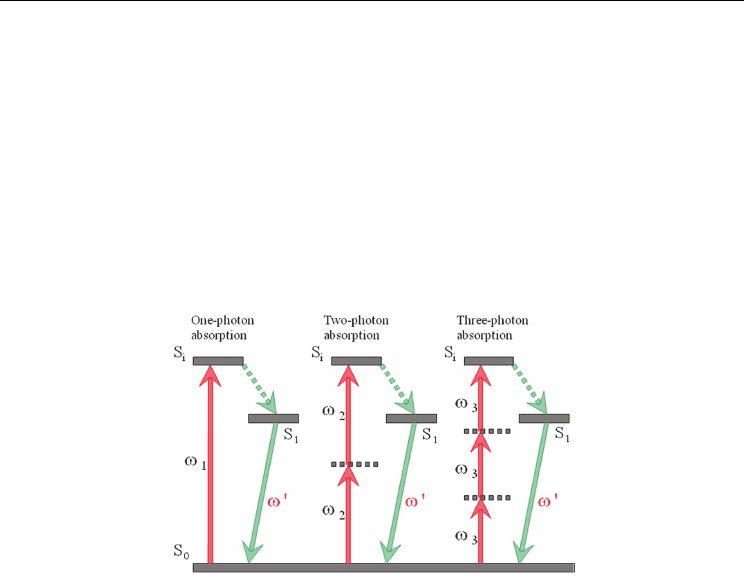
Nonlinear Optical Properties of Graphene and Carbon Nanotube Composites
401
where α in unit of m
-1
is the linear absorption coefficient and β in unit of m/W is the TPA
coefficient. Provided that the linear absorption is very small at lower intensity, we obtain the
solution for the transmission intensity
I(L)=I
0
/(1+I
0
βL). (4)
It is clearly seen from the solution that the transmission intensity decreases as the incident
intensity increases, resulting in OL phenomenon. The ability of TPA induced OL is strongly
dependent on the TPA coefficient, the incident intensity, as well as the propagation length L.
The TPA coefficient is related to the TPA cross section, a function of the exciting
wavelength. The OL of TPA materials is more effective for shorter incident pulses, since the
intensity of shorter pulses (ps or fs) is much higher than that of longer pulses (ns). The three-
photon absorption process exhibits very similar characteristics.
Fig. 4. Multi-photon absorption process.
In addition, it is worth discussing the difference of RSA and TPA processes under high
intensity approximation. For RSA process, the nonlinear transmittance originates completely
from the non-saturable ESA at very high intensities, hence tends to converge to a minimum
transmittance T
RSA
, which had been observed by Blau et al. in tetraphenylporphyrins in 1985
(Blau et al. 1985). The authors deduced analytically the expression for the minimum
transmittance T
RSA
, given by
T
RSA
=T
0
κ
(5)
where κ=σ
ex
/σ
0
is the ratio of excited state cross section (σ
ex
) to ground state cross section
(σ
0
). Obviously, the minimum transmission for RSA is a non-zero quantity, which is
dependent on κ, as well as the low intensity linear transmittance T
0
. For TPA process, the
transmitted intensity I(L) approaches a constant 1/βL at very high intensity I
0
→+∞, and
hence the final transmittance T
TPA
=I(L)/I
0
can reach to zero, resulting in a complete optical
limitation. On the contrary, the RSA process theoretically cannot realize the complete
limiting operation. Such difference between RSA and TPA is important for designing
practical optical limiters.
2.4 Free-carrier absorption (FCA)
In semiconductors, carriers can be generated by one-photon or two-photon exciting. As
shown in Fig. 5, these electron/hole pairs, by absorbing additional photons, can be excited
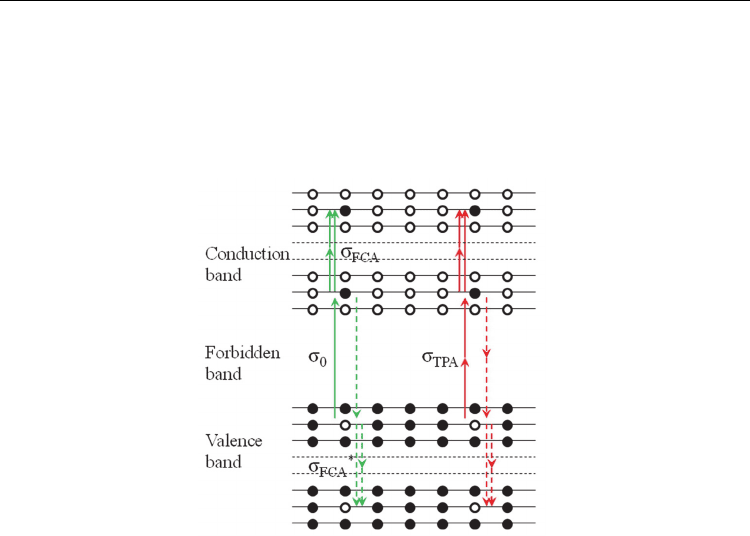
Carbon Nanotubes - Synthesis, Characterization, Applications
402
to states higher/lower in the conduction/valence band. The process is named ‘free-carrier
absorption’, which is similar to ESA in molecular system (Boggess et al. 1986). It should be
pointed out that there are four possible processes in a FCA medium – linear absorption,
TPA, one-photon induced FCA and two-photon induced FCA. For the simplest case, the
linearly excited one-photon induced FCA in Fig. 5 can be described by the propagation
equation
Fig. 5. Free-carrier absorption in semiconductor.
∂I/∂z=-(α+σ
FCA
N)I, (6)
where σ
FCA
is the FCA cross section. With the carrier density N given by ∂N/∂t=αI/hν, one
can get an approximate solution for the propagation equation
T=T
0
/[1+(1-T
0
)(F
0
σ
FCA
/4hν)], (7)
where T
0
is the linear transmission. When the peak incident fluence F
0
increases, the total
transmission T decreases, resulting in an OL effect. For the most complicated case, all four
processes take place in a FCA medium, then we have (Boggess et al. 1986; Tutt et al. 1993)
∂I/∂z=-(α+βI
2
+σ
FCA
N)I (8)
and
∂N/∂t=αI/hν+βI
2
/2hν. (9)
A range of semiconductor nanoparticles, metal nanocomposites and quantum dotes exhibit
FCA-induced OL effects. The FCA-induced NLO response is independent on the incident
pulse duration, provided that the duration is shorter than the diffusion and recombination
processes of free carriers. FCA is also insensitive to the particle size and geometry. It can
work in both solid state films and suspensions, covering broad temporal and wavelength
ranges. In many nanomaterials, FCA can coexist with NLS and TPA since the generation of
free carriers can arise from a TPA process.

Nonlinear Optical Properties of Graphene and Carbon Nanotube Composites
403
3. Graphene composites
Doubts about the stability of 2D crystals were finally dispelled by the discovery of graphene,
a hexagonally symmetric, covalently bonded 2D carbon monolayer (Novoselov et al. 2004;
Novoselov et al. 2005; Geim et al. 2007). Possessing excellent electronic properties, graphene
provides a route to study fundamental quantum phenomena, such as the quantum hall
effect in condensed-matter materials (Geim et al. 2007). Up to 10
5
cm
2
/V·s mobility of charge
carriers, which behave asmassless Dirac fermions in graphene, motivates the development
of graphene-based electronic devices, challenging traditional silicon-based electronics (Geim
et al. 2007).
In addition to the outstanding electronic, mechanical and thermal properties, graphene has
been discovered to possess unique optical and photonic properties, which are summarized
as follows.
1. The Dirac electrons in graphene have a linear dispersion between energy and
momentum near the Dirac point, resulting in a continuously resonate optical response
in a broadband spectral region from the visible to the near infrared (> 2.5 μm) (Geim et
al. 2007).
2. Monolayer graphene shows wavelength independent linear optical absorption. For any
low intensity light wave, the absorbance rigorously follows π·α≈2.3% per layer, where α
is the fine-structure constant. As a result, the absorbance of multilayer graphene is
proportional to the number of layers (Nair et al. 2008).
3. Graphene possesses ultrafast carrier dynamics due to the ultrafast carrier-carrier
scattering and carrier-phonon scattering. Under the fs pulse excitation, the intraband
equilibrium time is as short as ~100 fs and the intreband relaxation time is on a ps
timescale (Dawlaty et al. 2008).
4. Graphene has significant NLO properties. Depending on the different experimental
conditions, graphene and graphene oxide show NLS (Wang et al. 2009), ESA, TPA (Liu
et al. 2009) or saturable absorption (SA) (Bao et al. 2009; Sun et al. 2010). Four-wave
mixing experiment confirmed that the effective nonlinear susceptibility |χ
(3)
| is as large
as 10
-7
esu in graphene flakes (Hendry et al. 2010). The second harmonic generation was
also observed from a multi-layer graphene film (Dean et al. 2009).
5. Graphene oxide (GO) is a 2D network of mixed sp
2
and sp
3
carbon bondings. The
isolated nanoscale sp
2
domains in the sp
3
matrix leads to a bandgap in GO. The width
of the bandgap can be controlled by the size, shape and fraction of the sp
2
clusters,
achieving a tunable photoluminescence and electroluminescence (Eda et al. 2010; Loh et
al. 2010).
Before 2008, the study of photonic and optoelectronic properties of graphene have remained
theoretical. With the help of development of the low-cost, high-yield method for mass
production of graphene, the experimental study of NLO properties of graphene and
graphene derivatives has developed very rapidly since 2009. Hereinafter, we introduce the
NLO properties of graphene and its functionalized derivatives.
3.1 Graphene and graphene oxide
In contrast to micromechanical cleavage (Novoselov et al. 2005) and epitaxial growth (de
Heer et al. 2007), a recently developed liquid-phase exfoliation technique provides a low-
cost, high-yield method for mass production of unoxidized, defect-free graphene
(Hernandez et al. 2008; Lotya et al. 2009). In this method, the sieved graphite powder was
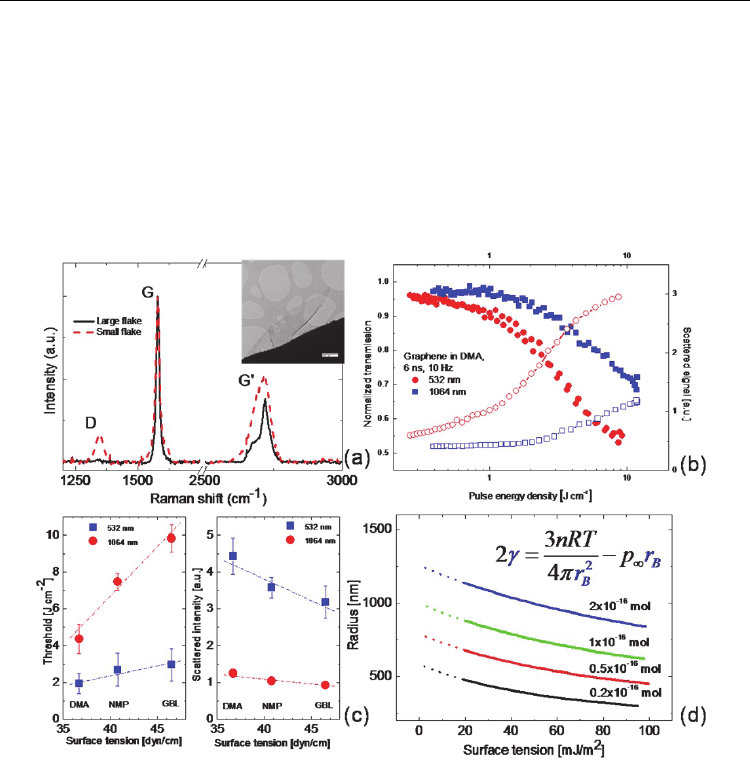
Carbon Nanotubes - Synthesis, Characterization, Applications
404
dispersed in a range of organic solvents. After the low power sonication treatment and
subsequent mild centrifugation to remove macroscopic aggregates, the homogeneous dark
dispersions were obtained. All dispersions were stable against sedimentation and with only
minimal aggregation occurring over a period of weeks. Experimental and theoretical
analyses reveal that the surface energies of the selected solvents, e.g., N-methyl-2-
pyrrolidone (NMP), N,N-dimethylacetamide (DMA), g-butyrolactone (GBL) etc., match very
well that of graphite (~70–80 mJ m
-2
), resulting in a minimal energy cost of overcoming the
van der Waals forces between two graphene sheets, hence the effective exfoliation to
graphene single or few layers (Bergin et al. 2008; Coleman 2009).
Fig. 6. TEM image, Raman spectra (a) and broadband OL (b) of the graphene dispersions.
Limiting threshold and scattered intensity as functions of surface tension of solvents (c).
Radius of the bubbles as a function of surface tension of solvents(d) (Wang et al. 2009).
Figure 6(a) show the TEM image and the Raman spectrum of graphene flakes prepared in γ-
butyrolactone by the liquid-phase exfoliation technique. In addition to the clear TEM graph
of the single-layer graphene flakes, the invisible D peak, as well as the clear G line and
characterized 2D band, in the Raman spectrum witness the existence of defect-free
monolayer and few-layer graphenes. We recently demonstrated that the liquid-phase
exfoliated graphene dispersions exhibit broadband OL for ns pulses at 532 and 1064 nm, as
shown in Fig. 6(b) (Wang et al. 2009). NLS, originating from the thermally induced solvent
bubbles and microplasmas, is responsible for this nonlinear behaviour. The surface tension
of the solvents has a strong influence on the OL performance of the graphene dispersions.
As shown in Fig. 6(c), it is clear seen that the lower the surface tension, the smaller the

Nonlinear Optical Properties of Graphene and Carbon Nanotube Composites
405
limiting threshold and the larger the scattered intensity. We established a simple model to
estimate the radius of the gas bubbles as a function of the surface tension of the dispersant.
The result in Fig. 6(d) reveals that the lower surface tension results in the larger bubble size,
hence more effective scattering and OL. In addition, the graphene flakes exhibit a similar OL
response to that of C
60
and SWNTs.
Zhou et al. prepared a stable graphene solution by reducing GO using a simple and clean
hydrothermal dehydration method, which can effectively remove oxygen-containing groups
in GO and restore the aromatic rings (Zhou et al. 2009). The NLO properties of the reduced
GO were measured by adsorbing the graphene on the end of an optical fiber, which guides a
1560 nm cw or 5 ns pulses laser beam for irradiation. The graphene exhibits a tunable NLA
as well as OL response for the NIR light by changing the preparation conditions, i.e.,
temperature and pressure, and hence the oxygen functional groups and structural defects in
graphene, which was confirmed by XPS, NMR and Raman spectroscopy.
The NLO properties of GO were studied by Liu et al. (Liu et al. 2009). Synthesized using the
modified Hummers method, the GO was dispersed in DMF for the linear optical and NLO
characterizations. UV-Vis spectrum of the GO dispersions shows an absorption peak at 268
nm, followed by a monotonously decreasing towards long wavelength region. Individual
GO sheets were observed in AFM graph. The pulse open aperture Z-scan study verified that
the RSA and TPA are mainly responsible for the NLO response of the GO solutions under ns
and ps pulses at 532 nm, respectively. However, the contribution from NLS was not
reported in Liu’s paper. Feng et al. investigated the NLO and OL properties of a range of
graphene derivatives, namely, graphene nanosheets, GO nanosheets, graphene nanoribbons
and GO nanoribbons (Feng et al. 2010). Broadband NLO responses at 532 and 1064 nm were
demonstrated in these graphene derivatives. Whereas the four derivatives exhibit different
OL behavior, the NLS dominates the NLO response at 1064 nm while both the NLS and
NLA contribute at 532 nm. Overall, the reduced graphenes possess better OL performance
than the corresponding GO precursors due to the increased conjugation and crystallinity.
The similar phenomenon was observed by Zhao et al., who found that the limiting response
of graphene nanosheets is better than that of the GO nanosheets owing to the extended π
conjugation in graphene (Zhao et al. 2010). In addition to the solvent dependent limiting
properties studied, broadband limiting effect was realized as well using graphene
nanosheets, which exhibit promising limiting at 532, 730, 800 and 1300 nm.
As with CNTs, the demonstration of graphene for OL renders graphene and related
materials as a new class of nanomaterial for photonic and optoelectronic nanodevices
(Bonaccorso et al. 2010). In the same way that nanotubes serve not only as nonlinear scatters
but also as host material for functional counterparts, which we introduce below, this unique
2D nanomaterial could be a promising host for an optical limiter as well as for other
photonic devices. Benefiting from the rich oxygen-containing groups, such as carboxyl and
carbonyl groups on the edge and hydroxyl and epoxy groups on the basal plane, GO sheets
can be decorated readily with a range of functional organic and inorganic materials by
covalent or noncovalent combination, forming diverse nanohybrids with certain function
(Loh et al. 2010).
3.2 Organic molecule functionalized graphene composites
For the NLO and OL applications, Xu et al. synthesized the first graphene hybrid by
functionalizing with a metal-free porphyrin - TPP-NH
2
. As shown in Fig. 7, the soluble
graphene nanohybrid exhibits an improved OL performance compared with C
60
, GO, TPP-
NH2 and the mixture of the TPP-NH2 and GO (Xu et al. 2009). A more detailed NLO study
reveals that the combination of multiple nonlinear mechanisms, i.e. RSA, TPA, NLS, as well
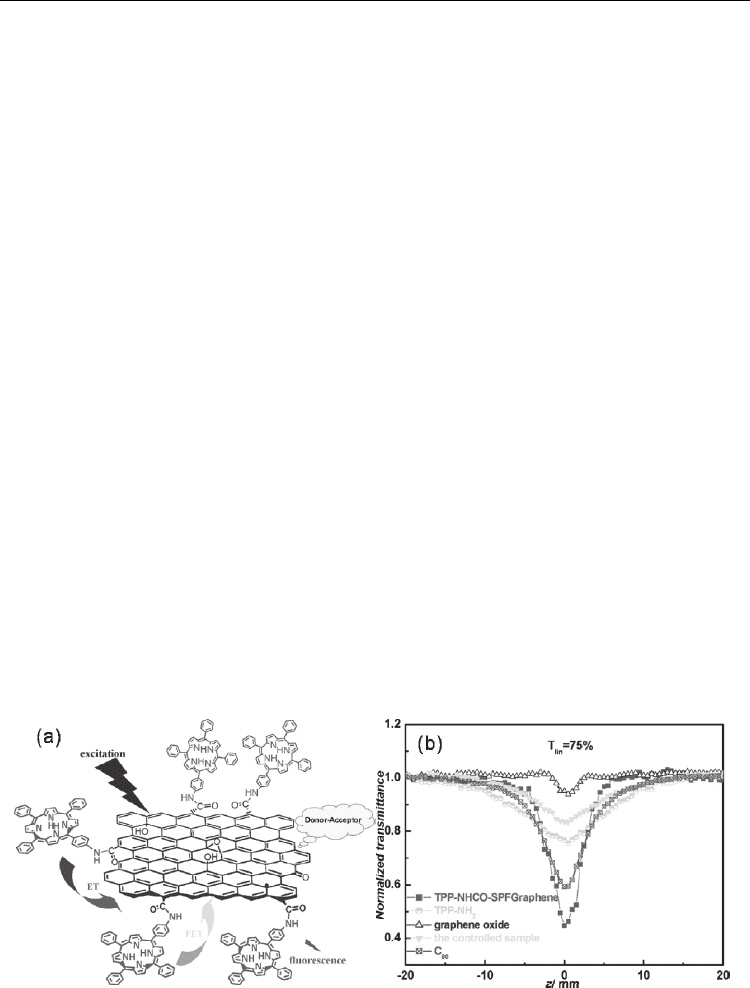
Carbon Nanotubes - Synthesis, Characterization, Applications
406
as photo-induced electron transfer results in the superior OL performance of the nanohybrid
(Liu et al. 2009). The similar accumulation effect resulting in improved OL was confirmed in
oligothiophene-graphene (Liu et al. 2009; Zhang et al. 2009) and fullerene-graphene (Liu et
al. 2009; Zhang et al. 2009) nanohybrid systems as well. Very recently, the NLO properties of
covalently linked graphene-metal porphyrins composite materials, namely, graphene-zinc
porphyrin and graphene-copper porphyrins, were reported by Krishna et al. (Krishna et al.
2011). Effective combination of the different OL mechanisms, say, NLA, TPA, NLS and
energy transfer in the graphene-porphyrin composites results in the improved OL effect for
ns pulses at 532 nm. In the hybrid system, the existence of NLS, arising from the graphene
moiety, can largely increase the damage threshold of the nano-composites. An energy
transfer model based on the graphene-porphyrin hybrids was developed and verified that
the energy transfer from porphyrin to graphene enhances the TPA of the system.
The role of energy transfer in the graphene based NLO materials was investigated by
Mamidala et al., who blended the electron acceptor GO with positively charged porphyrin
and negatively charged porphyrin, respectively (Mamidala et al. 2010). The NLO response
of the positively charged porphyrin-GO system is much larger than that of the negatively
charged porphyrin-GO system, confirming the important role of the energy transfer in such
donor-acceptor complexes. While NLS dominates the OL effect, the energy transfer
facilitates the deactivation of the hybrids, resulting in energy dissipation via the non-
radiative decay and hence the effective heat accumulation in the hybrids or heat transfer
from GO to the adjacent solvent. More pronounced energy transfer effect was seen in the
porphyrin-Au nanoparticle complex, probably due to the better electron accepting ability of
Au in comparison with the GO.
The analogous energy/electron transfer enhanced NLS was observed from a GO-dye ionic
complex (PNP
+
GO
-
) (Balapanuru et al. 2010). Compared with the pristine GO and the dye
PNPB, the charge-transfer composite exhibits much larger light scattering signal as well as
nonlinear transmission and OL for ns pulses at both 532 and 1064 nm. The organic dye can
effectively absorb the incident laser energy and transfer to the GO, resulting in the
ionization of the GO or further transfer to solvent, forming microplasmas or vapor bubbles
for NLS. From the above works, it should be pointed out that the energy transfer effect may
inspire deeply the design and synthesis of the new OL hybrid materials.
Fig. 7. The structure of the TPP-NH
2
functionalized GO (a) and the NLO response of the
TPP-NH
2
-GO compared with C
60
, GO, TPP-NH2 and the mixture of the TPP-NH2 and GO
(b) (Xu et al. 2009).
